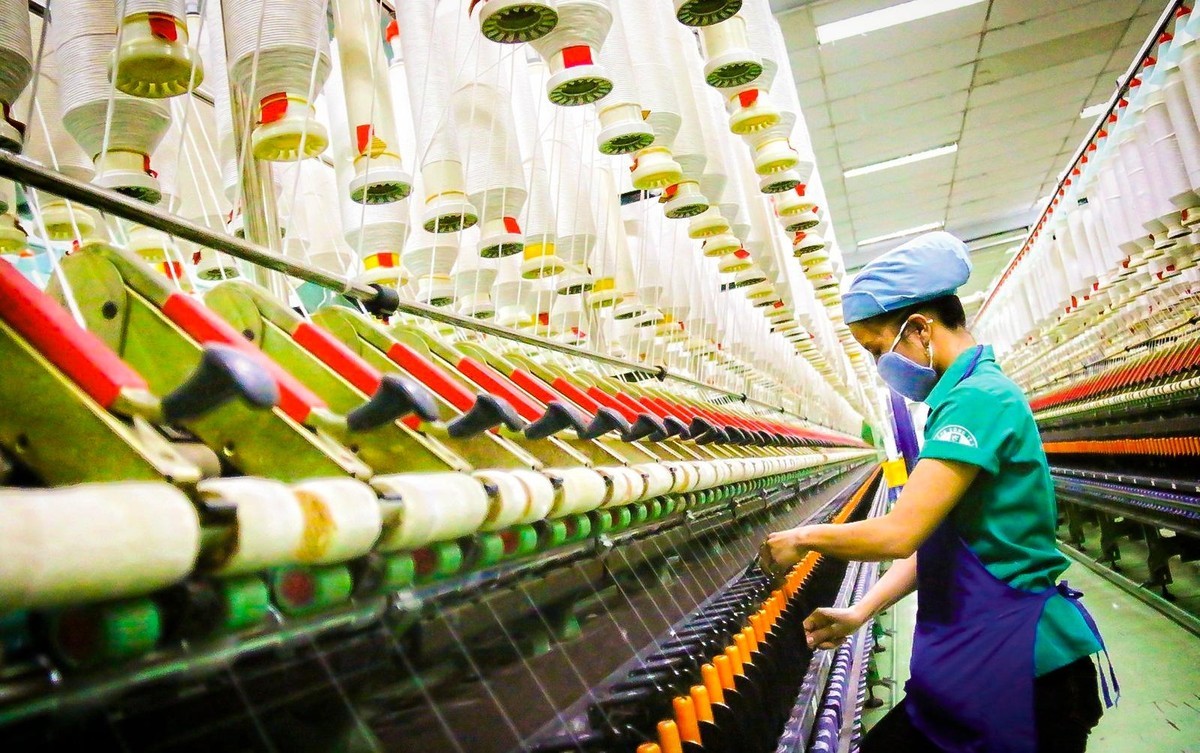The textile industry faces many negative signs in the second quarter of 2023
- 157
- Enterprise
- 23:11 19/05/2023
DNHN - The weak global demand for textiles and apparel hurts production activities, thereby reducing the demand for yarn products. In recent years, Vietnam has become one of the world's largest exporters of textiles and apparel.
In recent years, Vietnam has become one of the world's largest exporters of textiles and apparel. This industry's output and export value has increased dramatically, contributing significantly to Vietnam's GDP. The textile and garment industry in Vietnam has attracted significant foreign investment. Companies from Japan, Korea, and Taiwan have constructed factories in Vietnam to take advantage of the country's inexpensive labor and manufacturing costs.
However, Vietnam's textile and garment industry is reliant on material imports from China, India, and Bangladesh. Changes in the global supply chain, such as alterations in trade policy or climate change, can have an impact on the availability of materials and the cost of production in this industry.

According to a report by the Office of the Board of Directors of the Vietnam National Textile and Garment Group (Vinatex), Vietnam's textile and garment exports decreased by 20.6% in April 2023 compared to the same month the previous year, with an export turnover of USD 3.06 billion (compared to $USD 3.86 billionin April 2022).
In the first four months of 2023, the nation's exports of textiles and apparel totaled approximately 11.7 billion USD, down 20% from the same period the previous year (absolute value decreased by nearly 3 billion USD).
Regarding the textile and garment export market in April 2023, statistics indicate that all the major export markets decreased compared to the same period the previous year, with the US market decreasing by 30% and the export turnover reaching 1.15 billion USD, the European Union (EU) market decreasing by 9.7% to 349 million USD, the Korean market decreasing by 21% to 234 million USD, and Japan decreasing by 3%.
In the first four months of 2023, only the Japanese market increased by 6.6%, whereas the US and China markets decreased by over 30% compared to the same period the previous year, and the EU market decreased by 12%.

In addition to weaker exports, there are indications of trouble when the IIP in the first four months of 2023 did not generally record growth. In the third quarter of 2021, the employment indices of the Textile and Garment industries fell at a comparable rate.
China's textile and garment manufacturing activity remained negative at the start of 2023, even though the negative effects of the COVID-19 epidemic were nearly over. In March 2023, the Textile and Apparel industries' output decreased by 3.1% and 7.7%, respectively.
The weakening global demand for textiles and apparel hurts production activities, resulting in a decline in demand for yarn products. By the end of April, cotton prices had fallen to around $80 per pound (down 46% year-over-year), which is in line with the average for the period 2012-2019, indicating a decline in the industry's demand for input materials.
During the first quarter of 2023, the majority of garment companies generated unsatisfactory financial results. According to financial statement data, only two of the twenty textile and apparel companies on the floor that have announced business results for the first quarter of 2023 have positive profit growth, while thirteen have positive profit growth. negative profit growth, with five companies even reporting losses.
P.V (t/h)
Related news
- Connecting Leaders, Shaping the Future: Strategic Leadership Planning Meeting – CorporateConnections Hanoi A
- Sunlight - Unilever Vietnam Recognized for Outstanding Contributions to the National Initiative Supporting Women Entrepreneurs
- Deputy Prime Minister Nguyễn Chí Dũng: “The country’s major challenges weigh heavily on my mind — and we must resolve them together.
- Unitsky String Technologies signs cooperation agreements with three Vietnamese partners, opening a new direction for smart mobility and sustainable development
- When artists do business – livelihood is no poetry!
- Before the D‑day to abolish flat‑rate tax: Fear of technology and costs leave small traders struggling to adapt
- Vietnamese enterprises at a crossroads: the impact of a potential US–China deal
- "Digital technicians" must not be forgotten if Vietnam aims to meet its strategic goals
- HDBank: Impressive profit growth, leading in profitability and advancing international integration
- TNI King Coffee sued for over VND 5 Billion in unpaid debts
- VINASME and Jeonnam Technopark Sign MOU on technology cooperation, human resource training, and trade promotion
- Vietnamese entrepreneurs strengthen ASEAN connectivity in the digital iIntegration era
- Prime Minister: Vietnam aims to become a regional logistics hub
- Vietnam upgraded to Secondary Emerging Market by FTSE Russell
- Hanoi’s economy grows 7.92% in first nine months of 2025, FDI surges nearly threefold
- Vietnam’s strong gdp growth fails to ease labor market distress
- US tariffs on Brazil propel Vietnam’s pangasius into global spotlight
- VietLeap AI Accelerator launches: A strategic springboard for Vietnam’s AI startups
- CICON expands strategic alliances: A new step forward in Vietnam–Korea business connectivity
- What must Vietnamese enterprises do to maintain their position in the global supply chain?
Đọc thêm Enterprise
List of Vietnam’s 25 Best Workplaces 2025
Great Place To Work® has officially announced the 25 companies featured in the Best Workplaces in Vietnam™ 2025 ranking.
The ambitions of major enterprises in 2025
Major enterprises such as Dabaco, FPT, and KBC have set ambitious plans for 2025, demonstrating flexibility and sharpness in their business strategies.
What do domestic businesses need to overcome difficulties?
Strong and synchronized government support policies are crucial in helping Vietnamese enterprises navigate the current challenging period.
ACV achieved net profit surpassing VND 11,560 billion in 2024
Vietnam Airports Corporation (ACV) has recently announced its 2024 business results, reporting a net profit exceeding VND 11,560 billion, marking a 37% growth compared to the previous year.
Increasing taxes on pick-up trucks: The need to hear public opinion
The proposed tax increase on pick-up trucks is sparking debate. Many representatives argue that this decision could impact workers, businesses, and the domestic automotive market.
"The Vietnam-Korea Investment Cooperation Forum 2024 is a testament to the spirit of innovation and sustainable collaboration."
For Mr. Kim Ki-mun, Chairman of KBIZ, the Vietnam-Korea Investment Cooperation Forum 2024, scheduled for November 21, is not merely an event but also a testament to the spirit of innovation and sustainable collaboration between nations.
KBIZ's 60-year journey in building a solid foundation for South Korea's small and medium enterprise community
With over 60 years of establishment and development, the Korea Federation of SMEs (KBIZ) has emerged as a pioneering force in supporting the small and medium-sized enterprise (SME) community in South Korea.
What categories are included in the additional audit subjects?
On the morning of November 7, the National Assembly discussed the draft amendment of several articles across seven laws, with a particular focus on adding new audit subjects.
Institutional obstacles "tie up" enterprises and challenge economic growth
During a session discussing the 2024 socio-economic development plan, National Assembly deputies emphasized that institutional barriers remain a significant "obstacle" for businesses.
More than 1,000 new real estate businesses established in Ho Chi Minh City, transactions grow
In the first nine months of 2024, Ho Chi Minh City's real estate market witnessed the establishment of over 1,000 new businesses and recorded 1,600 property transactions, signaling a positive recovery trend.











